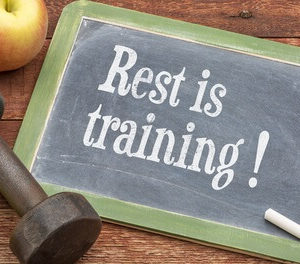Testing for Overtraining
Overtraining Is a Serious Problem
We have all done it at least once and have paid for it. If you engage in excessive high intensity interval training (HIIT) and diminished rest periods you may have feelings of constant tiredness, reduced performance, neural and hormonal changes, moody and frequent poor health.
Neuroendocrine Disorder
Overtraining syndrome frequently occurs in athletes who are training for a specific event or a competition and train beyond the body’s ability to recover. It’s a neuroendocrine disorder (meaning it affects nerves and hormones). This has sometimes previously been termed ‘burnout’ and ‘staleness’.
Athletes often exercise harder and longer so they can improve. But without adequate rest and recovery, these training regimens can actually decrease performance. Proper conditioning requires a balance between overload and recovery. Too much overload combined with too little recovery may result in both physical and psychology symptoms of overtraining syndrome.
Symptoms of Over-training:
• Fatigue
• Decreased appetite
• Washed-out feeling, tired, drained, lack of energy
• Sudden drop in performance
• Pain in muscles and joints
• Insomnia
• Headaches
• Decreased immunity (increased number of colds, and sore throats)
• Decrease in training capacity / intensity
• Moodiness and irritability
• Depression
• Mild leg soreness, general aches and pains
• Increased incidence of injuries.
• Loss of enthusiasm for the sport
Continued investigations may find the following:
• Hormonal changes
• Hematological changes (blood content)
• Neuroendocrine changes (elevated plasma noradrenalin and decreased excretion)
• Changes in the blood lactate threshold and concentration at a given exercise intensity
Several Ways to Recognize Overtraining Syndrome
Certified personal trainers know there are several ways to recognize overtraining syndrome. One test is by documenting your heart rates over time. Track your aerobic heart rate at a specific exercise intensities and speed throughout your training and write it down. If your pace starts to slow, your resting heart rate increases and you experience other symptoms, you may heading into overtraining syndrome. You can also track your resting heart rate each morning. Any marked increase from the norm may indicate that you aren’t fully recovered.
Orthostatic Heart Rate Test
The second option is the orthostatic heart rate test, developed by Heikki Rusko while working with cross country skiers. In obtaining this measurement you need to do the following:
• Lay flat and rest comfortably for 10 minutes the same time each day (morning is best).
• At the end of 10 minutes, record your heart rate in beats per minute.
• Then stand up.
• After 15 seconds, take a second heart rate in beats per minute.
• After 90 seconds, take a third heart rate in beats per minute.
• After 120 seconds, take a fourth heart rate in beats per minute.
Rested athletes will show a consistent heart rate between measurements, but Rusko found that a marked increase (10 beats/minutes or more) in the 120 second-post-standing measurement of athletes on the verge of over-training. Changes like this may indicate that you have not recovered from a previous workout, are fatigued and stressed. Is best to reduce training or rest another day before performing another workout. It’s important to listen to your body signals and rest when you feel tired. Making the habit of noting your activity within a training log will help you track downward trends.
Most Accurate Method for Testing
The most accurate method for testing for over-training and sensitive measurements are psychological signs, symptoms and changes in an athlete’s mental condition. Decreased positive feelings for sports and increased negative feelings, such as depression, anger, fatigue, and irritability often appears after days of intensive over-training. Studies have found increased ratings of perceived exertion during exercise after 3 days of overload.
Best Way to Treat Overtraining Syndrome
Research learned the best way in treating over-training syndrome is simple if you do the following:
• Rest and Recover. Try to do low levels or stop exercise and allow yourself a few days of rest.
• Hydrate, Drink plenty of fluids and alter your diet if necessary.
• Get a full tissue massage. This may help relax you mentally and physically.
• Begin Cross Training. This often helps athletes who are overworking certain muscles or suffering from mental fatigue.
It takes several weeks and should include proper nutrition and stress reduction to show complete recovery. It’s best to identify warning signs, and objectively measure your training routine and make changes before you wind up sick and injured. Changing up your training frequently and schedule in significant rest time is the best preventative method.
-
 Rest and Recovery Podcast$15.75
Rest and Recovery Podcast$15.75

